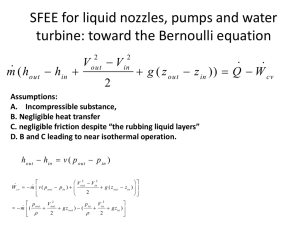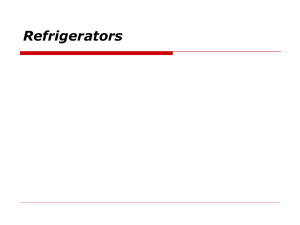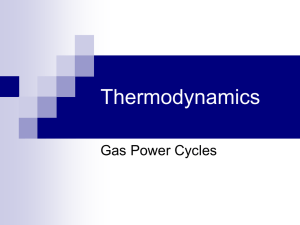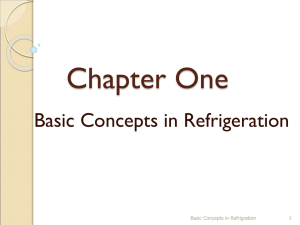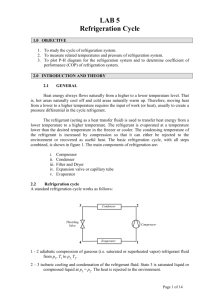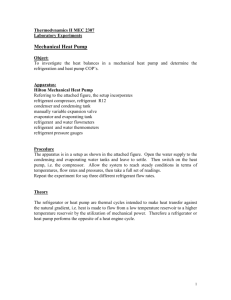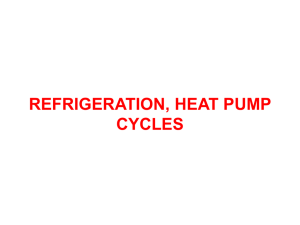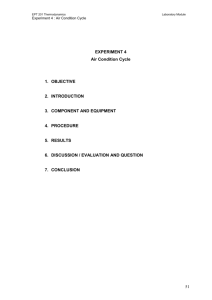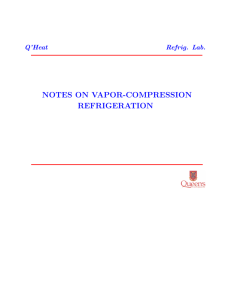The basic principle of refrigeration is simple. Just pass a colder
advertisement
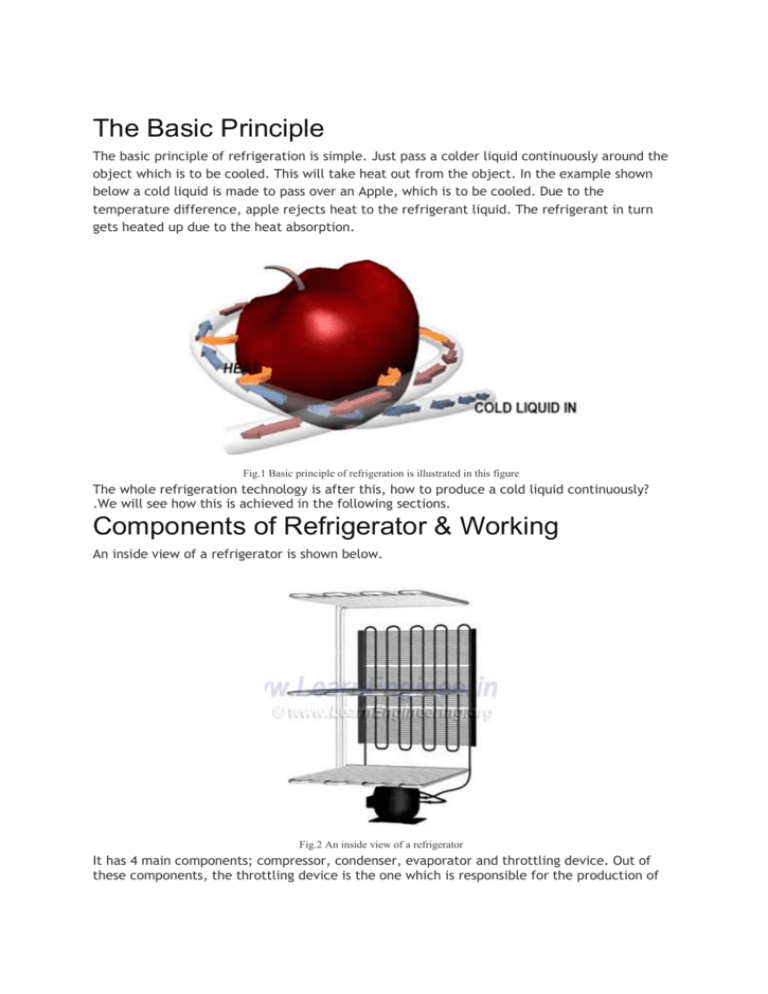
The Basic Principle The basic principle of refrigeration is simple. Just pass a colder liquid continuously around the object which is to be cooled. This will take heat out from the object. In the example shown below a cold liquid is made to pass over an Apple, which is to be cooled. Due to the temperature difference, apple rejects heat to the refrigerant liquid. The refrigerant in turn gets heated up due to the heat absorption. Fig.1 Basic principle of refrigeration is illustrated in this figure The whole refrigeration technology is after this, how to produce a cold liquid continuously? .We will see how this is achieved in the following sections. Components of Refrigerator & Working An inside view of a refrigerator is shown below. Fig.2 An inside view of a refrigerator It has 4 main components; compressor, condenser, evaporator and throttling device. Out of these components, the throttling device is the one which is responsible for the production of cold liquid. So we will first analyze the throttling device in a detailed way and move to the other components. Throttling Device Throttling device is an obstruction to the flow; cold liquid is produced with the help of this device. In this case throttling device is a capillary tube. Capillary tube has an approximate length of 2m and an inside diameter of around 0.6 mm, so it offers a great resistance to the flow. Fig.3 A Capillary tube: This results in sudden drop in pressure and temperature For effective throttling at the inlet, the refrigerant should be high pressure liquid. Throttling device is an obstruction to the flow, which causes tremendous pressure drop. Due to the drop in pressure, boiling point of refrigerant comes down, and it starts to evaporate. The heat required for evaporation comes within the refrigerant, so its temperature drops. If you check temperature across the throttling device, you can notice this drop. It is wrong to say that the throttling is a process. Because we know only the end points of throttling , that is states before and after throttling. We don’t know what are the states in between, since this is a highly irreversible change. So it would be correct to call throttling a phenomenon rather than a process. Evaporator - Heat Absorption Process Next phase is simple; just pass this cold liquid over the body where you have to absorb the heat. During the heat absorption process refrigerant further evaporates and transforms into pure vapor. A proper heat exchanger is required to carry the cold refrigerant over the body. This heat exchanger is known as evaporator. Fig.4 Cold liquid is passed through a heat exchanger know as evaporator for absorbing heat from the refrigerator So we have produced the required refrigeration effect. If we can take this low pressure vapor refrigerant to the state before throttling process, that is high pressure liquid state; we will be able to repeat this process. So first step, let’s raise the pressure. Compressor A compressor is introduced for this purpose. Compressor will raise the pressure back to its initial value. But since it is compressing gas, along with pressure, temperature will also raise. It is unavoidable. Fig.5 A compressor is used to raise pressure of the refrigerant Now the refrigerant is a high pressure vapor. To convert it to the liquid state we are introducing another heat exchanger. Condenser This heat exchanger is fitted outside refrigerator and refrigerant temperature is above atmospheric. So it will liberate heat to the surroundings. Vapor will get condensed to liquid and temperature will come down to normal level. Fig.6 Condenser heat exchanger is fitted outside the refrigerator so it will reject heat to the surroundings So the refrigerant is back to its initial state again, high pressure liquid. We can repeat this cycle over and over for continuous refrigeration. This cycle is known as vapor compression cycle. Refrigeration technology based on vapor compression cycle is the most used one in domestic and industrial applications. Refrigeration Accessories You can note more details of refrigerator components here. Evaporator and condenser are having fins attached to it. Fins will increase contact area available for convective heat transfer and thus will enhance heat transfer by a great extent. Fig.7 Fins attached to the condenser and evaporator Since evaporator is cooling the surrounding air, it is common that water will get condensed over it forming frost. Frost so formed will act as an insulator between evaporator heat exchanger and the surrounding air. Thus it will reduce effectiveness of heat removal process. Frequent removal of frost is required to enhance the heat transfer. An automatic defrosting mechanism is employed in all modern refrigerators. More on Compressor Apart from raising pressure, the compressor also helps in maintaining flow in the refrigerant circuit. Usually a hermetically sealed reciprocating type compressor, with proper sealing is used for this purpose. You might have noticed that refrigeration technology based on vapor compression cycle is a highly energy intensive affair. The reason is that compressing gas and raising pressure is a highly energy intensive process. Coefficient of Performance The heat and power transfer happening in a vapor compression refrigeration circuit is shown below. Fig.8 Energy interaction happening in a refrigeration system A simple energy balance of the system yields in the following relationship. It is often required to evaluate performance of a refrigerator or compare between different refrigeration technologies. A term called Coefficient of Performance (C.O.P) helps in doing this. To understand this term completely, we need to know what is the input and output of a refrigeration system. What we need from a refrigerator is the cooling effect. Or QABSORBED is the output of a refrigeration cycle. Input to the refrigerator is the power given to the compressor. So the term C.O.P can easily be defined as output by input and is as follows.

